Gallery
 Figure 2. Necrotic frizzled leaflets on older leaf of a potassium-deficient Dypsis cabadae . Photo by T.K. Broschat
Figure 2. Necrotic frizzled leaflets on older leaf of a potassium-deficient Dypsis cabadae . Photo by T.K. Broschat
Potassium Deficiency
Figure 2. Necrotic frizzled leaflets on older leaf of a potassium-deficient Dypsis cabadae. Photo by T.K. Broschat
Figure 2. Necrotic frizzled leaflets on older leaf of a potassium-deficient Dypsis cabadae. Photo by T.K. Broschat
 Figure 1. Potassium deficient older leaf of Dictyosperma album showing translucent yellow-orange spotting. Photo by T.K. Broschat
Figure 1. Potassium deficient older leaf of Dictyosperma album showing translucent yellow-orange spotting. Photo by T.K. Broschat
Potassium Deficiency
Figure 1. Potassium deficient older leaf of Dictyosperma album showing translucent yellow-orange spotting. Photo by T.K. Broschat
Figure 1. Potassium deficient older leaf of Dictyosperma album showing translucent yellow-orange spotting. Photo by T.K. Broschat
 Figure 4. Potassium-deficient older leaves of pygmy date palm ( Phoenix roebelenii ). Photo by T.K. Broschat
Figure 4. Potassium-deficient older leaves of pygmy date palm ( Phoenix roebelenii ). Photo by T.K. Broschat
Potassium Deficiency
Figure 4. Potassium-deficient older leaves of pygmy date palm (Phoenix roebelenii). Photo by T.K. Broschat
Figure 4. Potassium-deficient older leaves of pygmy date palm (Phoenix roebelenii). Photo by T.K. Broschat
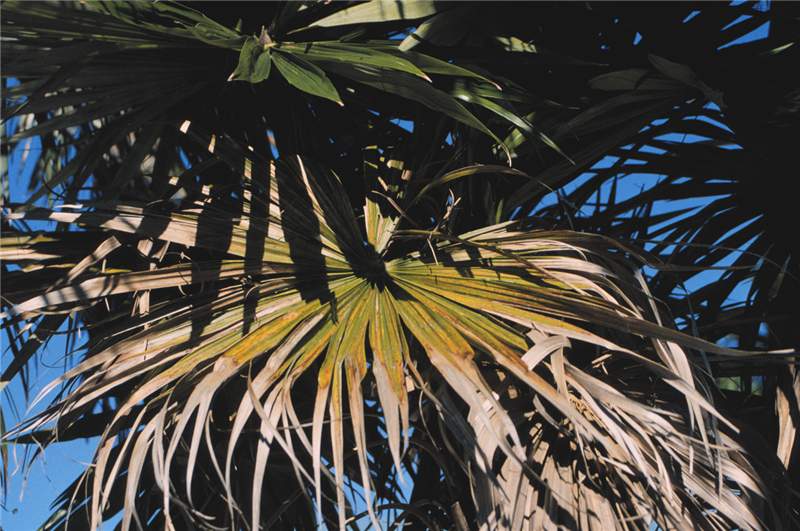 Figure 3. Potassium-deficient older leaf of Livistona chinensis showing leaf discoloration and leaflet tip necrosis. Photo by T.K. Broschat
Figure 3. Potassium-deficient older leaf of Livistona chinensis showing leaf discoloration and leaflet tip necrosis. Photo by T.K. Broschat
Potassium Deficiency
Figure 3. Potassium-deficient older leaf of Livistona chinensis showing leaf discoloration and leaflet tip necrosis. Photo by T.K. Broschat
Figure 3. Potassium-deficient older leaf of Livistona chinensis showing leaf discoloration and leaflet tip necrosis. Photo by T.K. Broschat
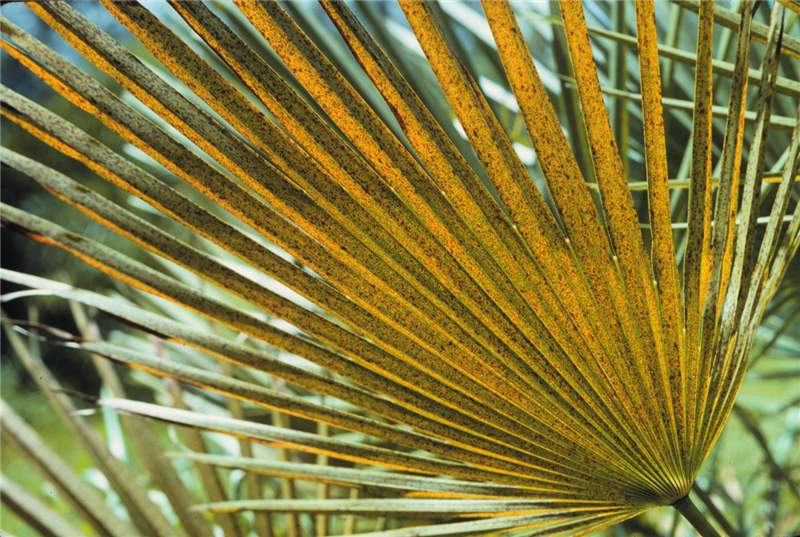 Figure 6. Potassium deficiency symptoms on older leaf of Chamaerops humilis . Note the translucent orange and necrotic spotting. Photo by T.K. Broschat
Figure 6. Potassium deficiency symptoms on older leaf of Chamaerops humilis . Note the translucent orange and necrotic spotting. Photo by T.K. Broschat
Potassium Deficiency
Figure 6. Potassium deficiency symptoms on older leaf of Chamaerops humilis. Note the translucent orange and necrotic spotting. Photo by T.K. Broschat
Figure 6. Potassium deficiency symptoms on older leaf of Chamaerops humilis. Note the translucent orange and necrotic spotting. Photo by T.K. Broschat
 Figure 5. Potassium deficiency symptoms on older leaves of fishtail palm ( Caryota mitis ). Photo by T.K. Broschat
Figure 5. Potassium deficiency symptoms on older leaves of fishtail palm ( Caryota mitis ). Photo by T.K. Broschat
Potassium Deficiency
Figure 5. Potassium deficiency symptoms on older leaves of fishtail palm (Caryota mitis). Photo by T.K. Broschat
Figure 5. Potassium deficiency symptoms on older leaves of fishtail palm (Caryota mitis). Photo by T.K. Broschat
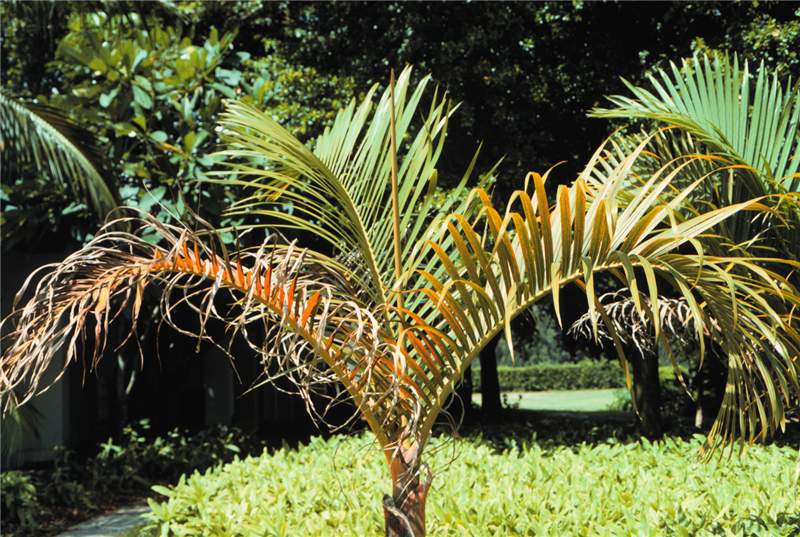 Figure 8. Potassium-deficient spindle palm ( Hyophorbe verschafeltii ) showing increasing severity with leaf age. Photo by T.K. Broschat
Figure 8. Potassium-deficient spindle palm ( Hyophorbe verschafeltii ) showing increasing severity with leaf age. Photo by T.K. Broschat
Potassium Deficiency
Figure 8. Potassium-deficient spindle palm (Hyophorbe verschafeltii) showing increasing severity with leaf age. Photo by T.K. Broschat
Figure 8. Potassium-deficient spindle palm (Hyophorbe verschafeltii) showing increasing severity with leaf age. Photo by T.K. Broschat
 Figure 7. Potassium deficient older leaf of areca palm ( Dypsis lutescens ) showing increasing severity towards the leaf tip. Photo by T.K. Broschat
Figure 7. Potassium deficient older leaf of areca palm ( Dypsis lutescens ) showing increasing severity towards the leaf tip. Photo by T.K. Broschat
Potassium Deficiency
Figure 7. Potassium deficient older leaf of areca palm (Dypsis lutescens) showing increasing severity towards the leaf tip. Photo by T.K. Broschat
Figure 7. Potassium deficient older leaf of areca palm (Dypsis lutescens) showing increasing severity towards the leaf tip. Photo by T.K. Broschat
 Figure 10. Late stage potassium deficiency in coconut palm ( Cocos nucifera ) showing chlorotic, necrotic new leaves and tapered trunk. This palm died shortly after this photo was taken. Photo by T.K. Broschat
Figure 10. Late stage potassium deficiency in coconut palm ( Cocos nucifera ) showing chlorotic, necrotic new leaves and tapered trunk. This palm died shortly after this photo was taken. Photo by T.K. Broschat
Potassium Deficiency
Figure 10. Late stage potassium deficiency in coconut palm (Cocos nucifera) showing chlorotic, necrotic new leaves and tapered trunk. This palm died shortly after this photo was taken. Photo by T.K. Broschat
Figure 10. Late stage potassium deficiency in coconut palm (Cocos nucifera) showing chlorotic, necrotic new leaves and tapered trunk. This palm died shortly after this photo was taken. Photo by T.K. Broschat
Potassium Deficiency
Figure 9. Severely potassium-deficient Sabal palmetto. Photo by T.K. Broschat
Figure 9. Severely potassium-deficient Sabal palmetto. Photo by T.K. Broschat
 Figure 1. Powerline decline of Cocos nucifera . Note chlorotic and necrotic leaf tips. Photo by T.K. Broschat
Figure 1. Powerline decline of Cocos nucifera . Note chlorotic and necrotic leaf tips. Photo by T.K. Broschat
Powerline Decline
Figure 1. Powerline decline of Cocos nucifera. Note chlorotic and necrotic leaf tips. Photo by T.K. Broschat
Figure 1. Powerline decline of Cocos nucifera. Note chlorotic and necrotic leaf tips. Photo by T.K. Broschat
 Figure 2. Powerline decline on Syagrus romanzoffiana showing chlorotic and necrotic leaf tips. Photo by T.K. Broschat
Figure 2. Powerline decline on Syagrus romanzoffiana showing chlorotic and necrotic leaf tips. Photo by T.K. Broschat
Powerline Decline
Figure 2. Powerline decline on Syagrus romanzoffiana showing chlorotic and necrotic leaf tips. Photo by T.K. Broschat
Figure 2. Powerline decline on Syagrus romanzoffiana showing chlorotic and necrotic leaf tips. Photo by T.K. Broschat
Red Ring
Figure 1. Cocos nucifera with premature death of older leaves. Photo by M. L. Elliott.
Figure 1. Cocos nucifera with premature death of older leaves. Photo by M. L. Elliott.
Red Ring
Figure 2. Cross-section through Cocos nucifera trunk exhibiting typical ring discoloration pattern near the outside edge of the trunk. Photo by R. M. Giblin-Davis, University of Florida.
Figure 2. Cross-section through Cocos nucifera trunk exhibiting typical ring discoloration pattern near the outside edge of the trunk. Photo by R. M. Giblin-Davis, University of Florida.
 Figure 1. Iron deficiency symptoms caused by root suffocation in Licuala spinosa . Photo by T.K. Broschat
Figure 1. Iron deficiency symptoms caused by root suffocation in Licuala spinosa . Photo by T.K. Broschat
Root Suffocation
Figure 1. Iron deficiency symptoms caused by root suffocation in Licuala spinosa. Photo by T.K. Broschat
Figure 1. Iron deficiency symptoms caused by root suffocation in Licuala spinosa. Photo by T.K. Broschat
 Figure 2. Iron deficiency caused by deep planting in Acoelorrhaphe wrightii . Photo by T.K. Broschat
Figure 2. Iron deficiency caused by deep planting in Acoelorrhaphe wrightii . Photo by T.K. Broschat
Root Suffocation
Figure 2. Iron deficiency caused by deep planting in Acoelorrhaphe wrightii. Photo by T.K. Broschat
Figure 2. Iron deficiency caused by deep planting in Acoelorrhaphe wrightii. Photo by T.K. Broschat
Royal Palm Bug Damage
Figure 1. Early damage caused by royal palm bug (Xylastodoris luteolus). Photo by T.K. Broschat
Figure 1. Early damage caused by royal palm bug (Xylastodoris luteolus). Photo by T.K. Broschat
Royal Palm Bug Damage
Figure 2. Severe damage caused by royal palm bug (Xylastodoris luteolus). Photo by T.K. Broschat
Figure 2. Severe damage caused by royal palm bug (Xylastodoris luteolus). Photo by T.K. Broschat
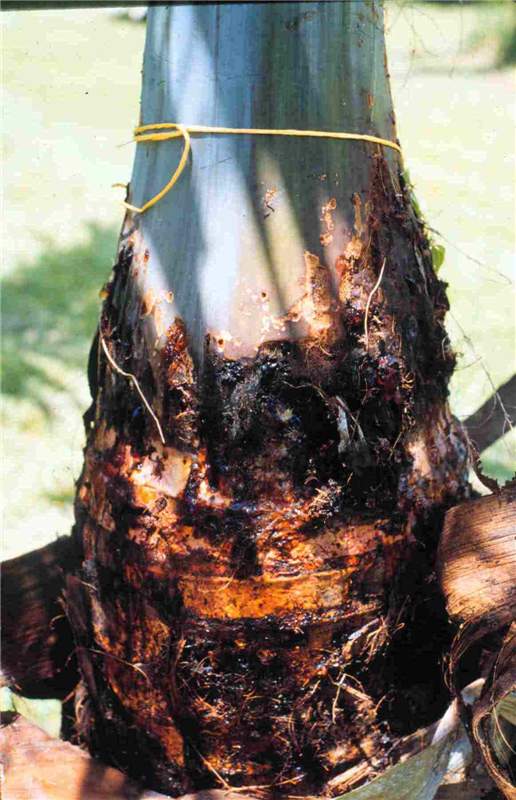 Figure 2. Feeding damage caused by larvae of Metamasius hemipterus on spindle palm ( Hyophorbe verschafeltii ). Photo by T.K. Broschat
Figure 2. Feeding damage caused by larvae of Metamasius hemipterus on spindle palm ( Hyophorbe verschafeltii ). Photo by T.K. Broschat
Silky Sugar Cane Weevil Damage
Figure 2. Feeding damage caused by larvae of Metamasius hemipterus on spindle palm (Hyophorbe verschafeltii). Photo by T.K. Broschat
Figure 2. Feeding damage caused by larvae of Metamasius hemipterus on spindle palm (Hyophorbe verschafeltii). Photo by T.K. Broschat
 Figure 1. Exudate from oviposition holes caused by Metamasius hemipterus in spindle palm ( Hyophorbe verschafeltii ). Photo by R. Giblin-Davis.
Figure 1. Exudate from oviposition holes caused by Metamasius hemipterus in spindle palm ( Hyophorbe verschafeltii ). Photo by R. Giblin-Davis.
Silky Sugar Cane Weevil Damage
Figure 1. Exudate from oviposition holes caused by Metamasius hemipterus in spindle palm (Hyophorbe verschafeltii). Photo by R. Giblin-Davis.
Figure 1. Exudate from oviposition holes caused by Metamasius hemipterus in spindle palm (Hyophorbe verschafeltii). Photo by R. Giblin-Davis.
 Figure 4. Phoenix canariensis infested with Metamasius hemipterus . Note older living leaves hanging down against trunk. Photo by T.K. Broschat
Figure 4. Phoenix canariensis infested with Metamasius hemipterus . Note older living leaves hanging down against trunk. Photo by T.K. Broschat
Silky Sugar Cane Weevil Damage
Figure 4. Phoenix canariensis infested with Metamasius hemipterus. Note older living leaves hanging down against trunk. Photo by T.K. Broschat
Figure 4. Phoenix canariensis infested with Metamasius hemipterus. Note older living leaves hanging down against trunk. Photo by T.K. Broschat
 Figure 3. Feeding damage caused by Metamasius hemipterus on spindle palm ( Hyophorbe verschafeltii ). Photo by R. Giblin-Davis.
Figure 3. Feeding damage caused by Metamasius hemipterus on spindle palm ( Hyophorbe verschafeltii ). Photo by R. Giblin-Davis.
Silky Sugar Cane Weevil Damage
Figure 3. Feeding damage caused by Metamasius hemipterus on spindle palm (Hyophorbe verschafeltii). Photo by R. Giblin-Davis.
Figure 3. Feeding damage caused by Metamasius hemipterus on spindle palm (Hyophorbe verschafeltii). Photo by R. Giblin-Davis.
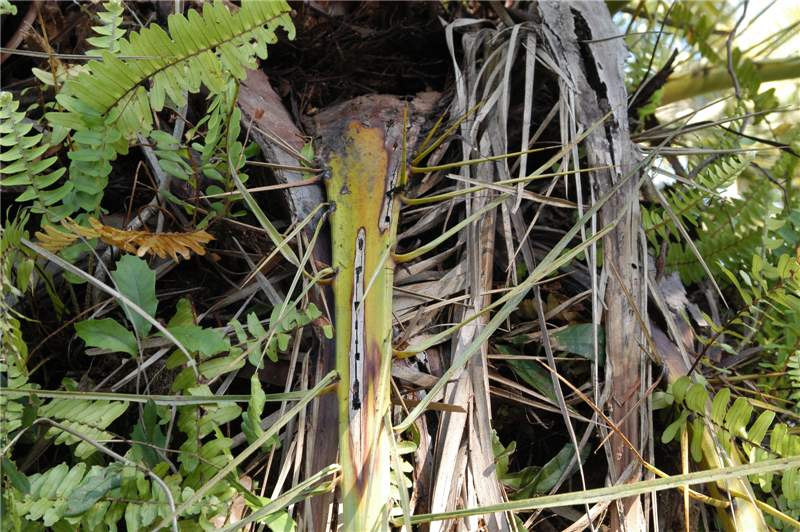 Figure 5. Close-up of leaf base of Phoenix canariensis infested with Metamasius hemipterus . Photo by T.K. Broschat
Figure 5. Close-up of leaf base of Phoenix canariensis infested with Metamasius hemipterus . Photo by T.K. Broschat
Silky Sugar Cane Weevil Damage
Figure 5. Close-up of leaf base of Phoenix canariensis infested with Metamasius hemipterus. Photo by T.K. Broschat
Figure 5. Close-up of leaf base of Phoenix canariensis infested with Metamasius hemipterus. Photo by T.K. Broschat
 Figure 1. Leaf tip necrosis caused by high soil soluble salts on Syagrus romanzoffiana seedling. Photo by T.K. Broschat.
Figure 1. Leaf tip necrosis caused by high soil soluble salts on Syagrus romanzoffiana seedling. Photo by T.K. Broschat.
Soil Soluble Salts Injury
Figure 1. Leaf tip necrosis caused by high soil soluble salts on Syagrus romanzoffiana seedling. Photo by T.K. Broschat.
Figure 1. Leaf tip necrosis caused by high soil soluble salts on Syagrus romanzoffiana seedling. Photo by T.K. Broschat.
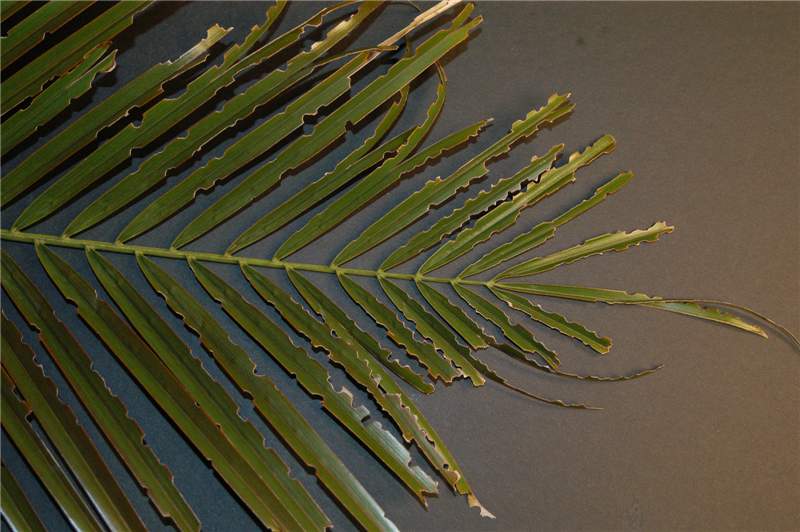 Figure 1. Phoenix roebelenii leaf showing notching caused by Sri Lanka weevil. Photo by T.K. Broschat.
Figure 1. Phoenix roebelenii leaf showing notching caused by Sri Lanka weevil. Photo by T.K. Broschat.
Sri Lanka Weevil Damage
Figure 1. Phoenix roebelenii leaf showing notching caused by Sri Lanka weevil. Photo by T.K. Broschat.
Figure 1. Phoenix roebelenii leaf showing notching caused by Sri Lanka weevil. Photo by T.K. Broschat.
Tar Spot
Figure 1. The raised black structures on this leaf are stromata, a mixture of host tissue and mycelia of Phaeochoropsis neowashingtoniae. Photo by A. J. Downer, University of California.
Figure 1. The raised black structures on this leaf are stromata, a mixture of host tissue and mycelia of Phaeochoropsis neowashingtoniae. Photo by A. J. Downer, University of California.
 Figure 1. Damage caused by formosan termites ( Coptotermes formosanus ) on Pritchardia petioles. Photo by Scot Nelson.
Figure 1. Damage caused by formosan termites ( Coptotermes formosanus ) on Pritchardia petioles. Photo by Scot Nelson.
Termite Damage
Figure 1. Damage caused by formosan termites (Coptotermes formosanus) on Pritchardia petioles. Photo by Scot Nelson.
Figure 1. Damage caused by formosan termites (Coptotermes formosanus) on Pritchardia petioles. Photo by Scot Nelson.
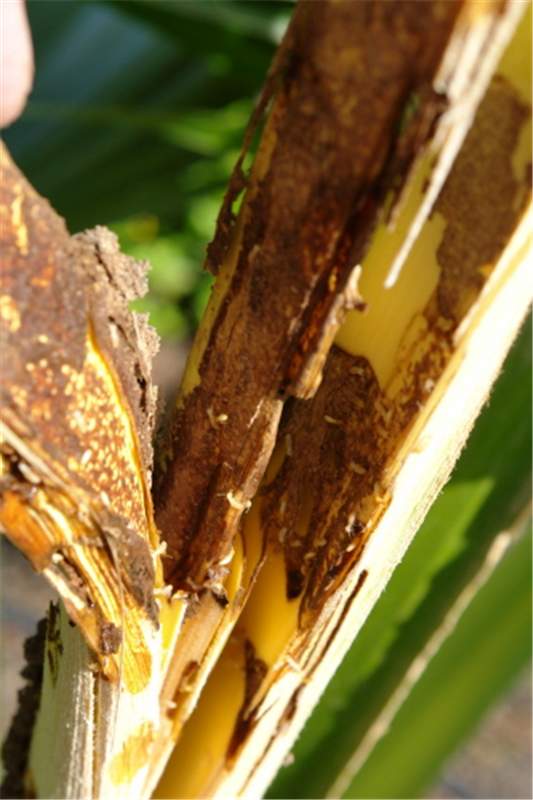 Figure 2. Feeding damage and frass caused by formosan termite ( Coptotermes formosanus ) on Pritchardia. Photo by Scot Nelson.
Figure 2. Feeding damage and frass caused by formosan termite ( Coptotermes formosanus ) on Pritchardia. Photo by Scot Nelson.
Termite Damage
Figure 2. Feeding damage and frass caused by formosan termite (Coptotermes formosanus) on Pritchardia. Photo by Scot Nelson.
Figure 2. Feeding damage and frass caused by formosan termite (Coptotermes formosanus) on Pritchardia. Photo by Scot Nelson.
Texas Phoenix Palm Decline
Figure 2. This Phoenix sylvestris has one necrotic older leaf and three other older leaves with initial leaf symptoms - brief yellowing period followed by complete necrosis. Photo by M. L. Elliott.
Figure 2. This Phoenix sylvestris has one necrotic older leaf and three other older leaves with initial leaf symptoms - brief yellowing period followed by complete necrosis. Photo by M. L. Elliott.
Texas Phoenix Palm Decline
Figure 1. This Phoenix dactylifera dropped almost all of its fruit in just 2 to 3 days. Photo by M. L. Elliott.
Figure 1. This Phoenix dactylifera dropped almost all of its fruit in just 2 to 3 days. Photo by M. L. Elliott.
Texas Phoenix Palm Decline
Figure 4. Phoenix sylvestris with significantly more dead leaves than would be normal. Note the reddish-brown coloration of the leaves.Photo by B. Dick, City of Lakeland, Florida.
Figure 4. Phoenix sylvestris with significantly more dead leaves than would be normal. Note the reddish-brown coloration of the leaves.Photo by B. Dick, City of Lakeland, Florida.
Texas Phoenix Palm Decline
Figure 3. The Phoenix canariensis in the center and on the right have more dead leaves than would be normal, and are in contrast to the healthy palm on the left. Photo by M. L. Elliott.
Figure 3. The Phoenix canariensis in the center and on the right have more dead leaves than would be normal, and are in contrast to the healthy palm on the left. Photo by M. L. Elliott.




